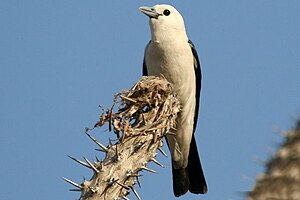Vanga strangler
| Vanga strangler | ||||||||||||
|---|---|---|---|---|---|---|---|---|---|---|---|---|

Bald Vanga ( Artamella viridis ) |
||||||||||||
| Systematics | ||||||||||||
|
||||||||||||
| Scientific name | ||||||||||||
| Vangidae | ||||||||||||
| Swainson , 1831 |
The Vangawürger (Vangidae), also called blue shrike , form a family in the order of the passerine birds (Passeriformes). Vanga stranglers occur exclusively in Madagascar and the neighboring Comoros . The family comprises 15 genera with 22 species.
The Vanga stranglers are very diverse and specialized songbirds that have developed as isolated island species. Similar to the Darwin's finches ( Galápagos Islands ) or the honeysuckle ( Hawaii ), the individual species occupied different ecological niches due to a lack of competition and developed far apart in the course of evolution. However, they are assigned to a family due to the few clear characteristics, such as the structure of the skull and the palate.
features
The greatest distinguishing features exist between the species in size, plumage color and beak shape. Thus, the features Sichelvanga ( Falculea palliata ) for a long, saber-like beak Helmvanga ( euryceros prevostii ) a heavy thickened beak slightly arched upwardly and seated on the apex and the Hakenschnabelvanga ( Vanga curvirostris ) via a straight beak which bends down like a hook at the end of the upper beak. Thus, in the course of evolution, the beak has adapted to the respective foraging and eating habits.
The sickle vanga with 32 centimeters is one of the largest species; the smallest species are the magpie vanga ( Leptopterus chabert ) and the red-tailed vanga ( Calicalicus madagascariensis ) with about 14 centimeters.
Occurrence and way of life
Vanga stranglers are endemic to Madagascar with the exception of the blue vangas ( Cyanolanius madagascarinus ), which also inhabits areas in the Comoros. They go looking for food individually or in small groups. They prefer to stay in the dense canopy of leaves in the woods, where they feed on the insects and other invertebrates found on the leaves, twigs and branches. The nuthatch vanga ( Hypositta corallirostris ), like the nuthatch ( Sitta europaea ), specializes in prey hidden in the crevices of the trees. In contrast to the nuthatch, however, it runs up the trees.
They create their bowl-shaped nests in the trees. The breeding season is usually between October and January, with the exception of the nuthatch and the black vanga ( Oriolia bernieri ), which nest in August and September. A clutch consists of one to four eggs, which are colored differently depending on the species. The vangas use root fibers, leaf stalks, mosses and cobwebs as nesting material.
threat
The IUCN has listed the helmet vanga, the red shoulder vanga ( Calicalicus rufocarpalis ) and the black vanga as endangered (Vulnerable) since 2000. The main cause is the deforestation. The reasons for this were the too small population sizes and the too small restricted distribution areas, as well as the populations dismembered by the deforestation, especially in the Helmvanga.
Genera and species
The family consists of 15 genera with 22 species. The identity of the short-toed nuthatch , which was only described in 1996 on the basis of two bellows in the Senckenberg Nature Museum , was revealed to be a juvenile specimen of the white-throated foditany based on a new genetic analysis in 2013. The bellows were collected in 1931 in southeast Madagascar, not far from the city of Tolagnaro .
|
|
swell
literature
- TS Schulenberg: Vangidae, Vangas, in Steven M. Goodman, Jonathan P. Benstead, Harald Schütz: The Natural History of Madagascar , University of Chicago Press, ISBN 0-226-30307-1
- Publisher: Forshaw, Joseph: Encyclopedia of Birds , 1999 - ISBN 3-8289-1557-4
